MARKETING (IB)
Overview of International Marketing
Marketing
- Identifying and meeting human and social needs or meeting needs profitability – Keller & Kotler
- Activity and processes for creating, communicating, delivering, and capturing offerings that have value for customers, partners, and society – AMA
- Process of continuously and profitably satisfying customer’s needs, wants, and expectations superior to competition – Go & Escareal-Go
- Making your organization happy, by making your customers happy.
Marketing Management: art and science of choosing target markets; getting, keeping, and growing customers through creating, delivering, and communicating superior customer value.
Strategic C’s of Marketing: customers, competition, company
3Cs | Key Objectives |
|---|---|
Customers | Satisfy needs, wants, and expectations of customers. |
Competition | Outperform competition |
Company | Ensure corporate health and profit. |
Basic Marketing Principles
General Marketing Principles for achievement of organizational objectives.
- Adapt the marketer’s concept: consumer-orientedness.
- Discover and satisfy needs and wants.
- Identify competitive edge and position among competitors.
- Offer something valuable and unique.
- Be accessible and available at the right moment, in the right place, with the right quantity.
- Set the price based on the value to the consumer, cost to the company, and advantage to the competitor.
- Create great customer experience.
- Communicate the elements of the basic principles strategically to encourage purchase.
- Develop sustainable and profitable relationships.
International Marketing
- Utilization and adaptation of best marketing practices for the purpose of conducting commerce in other countries.
- Focus of an organization’s resources and competencies on global market opportunities and threats. A company engages in global marketing conducts important business activities outside the home-country market.
- International marketing consists of the activity, institutions, and process across national borders that create, communicate, deliver, and exchange offerings that have value for stakeholders and society.
- International marketing consists of the activities, institutions, and processes across national borders that create, communicate, deliver, and exchange offerings that have value for stakeholders and society.
- International marketing is the performance of business activities designed to plan, price, promote, and direct the flow of a company’s goods and services to consumers or users more than one nation for a profit.
- Satisfying customers beyond national borders profitably.
Comparing International Marketing
Domestic Marketing: marketing practices within a home country. International and domestic marketing are similar in nature but not in space.
International Trade Economics: concerned with flow of goods in a macro (country/region) level while international marketing focuses on strategies on the micro-level (company).
World/Global/Multinational: the perspective where nothing is foreign, the world is their home and they are corporate citizens of the world, whereas in international marketing, there is a home country and there is a foreign country they are targeting.
Same principles apply but in a different environment, same process is followed but in a different/wider scope, same goals are targeted and achieved but considers different consumers. The focus of effort lies understanding the country and how to enter that country.
International Marketing Framework
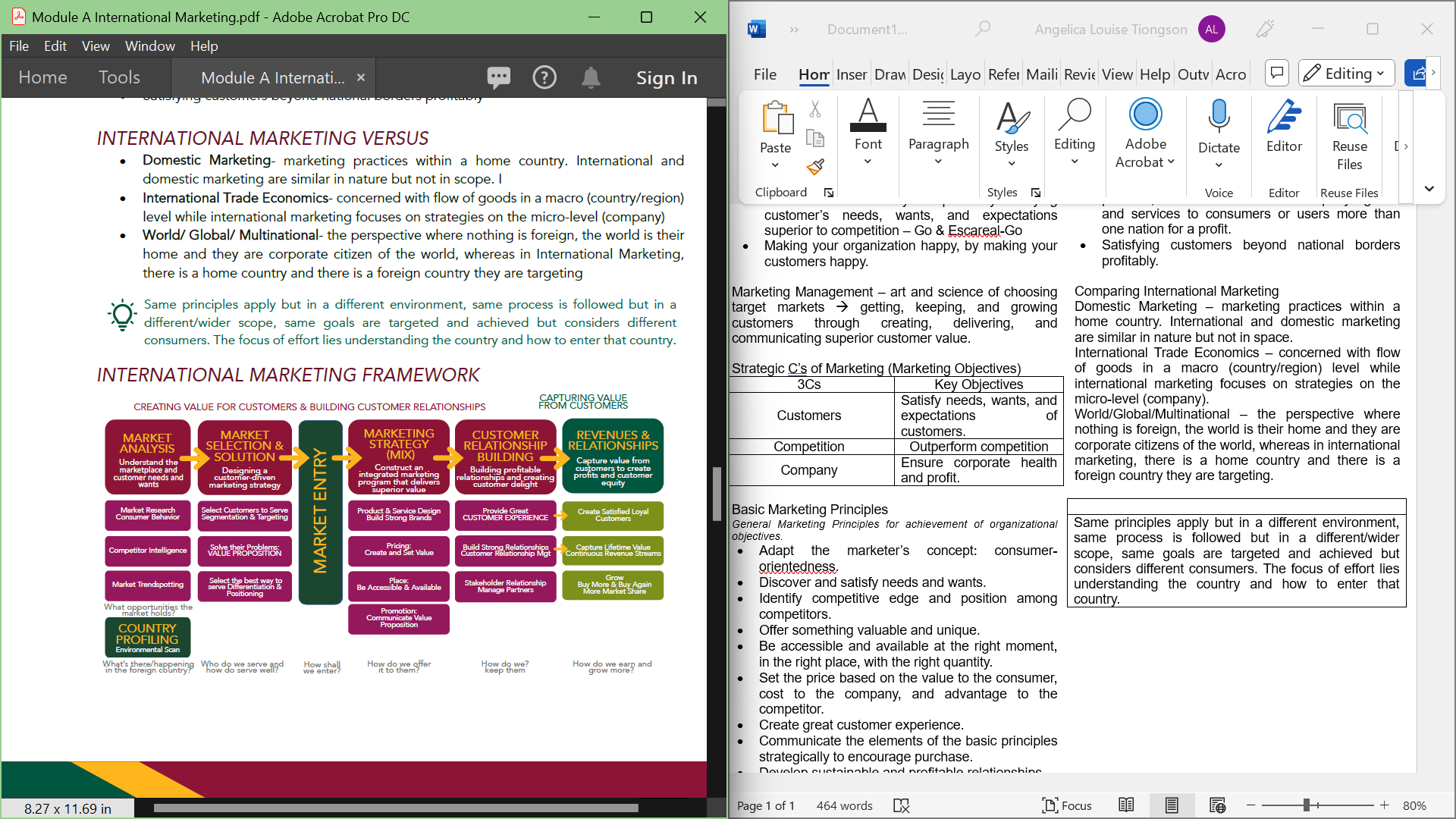
Driving Forces
Consumer | Business | Country |
|---|---|---|
Converging market needs and wants | Advancement in ICT and online platforms for trade. | Opening of borders and favorable trade policies and agreements among countries. |
Exploration and diversity of consumer taste and preferences | Improvements and efficiency in transportation and communications. | |
Popularity and accessibility of media; affinity of people towards foreign culture & consumption. |
Benefits of International Marketing
Consumer | Business | Country |
|---|---|---|
Variety: Consumers having more options, satisfying their diverse needs and wants | Higher revenue and profits; additional stream of income. | Additional employment for the home country. |
Diversification: less dependence on one market. | Income contribution to GNP through exports. | |
Larger customer base for economies of scale. | Moderation of inflation (from importers given more affordable products). | |
International servicing of locals in foreign market, specifically for Filipinos being widespread in the globe. | A fresh identity and equity for an organization. | Moderation of exchange rates (from exporters bringing more foreign currency). |
Having a foreign presence, a “global” business enjoys an advantage. | Promotion of home culture. | |
Competitiveness as it aligns itself with the standards of the competitors. |
Arguments Against International Marketing
- Threat to national security (Tiktok, Huawei)
- Capacity: Not every market and industry are capable of international marketing.
- Anti-competitiveness: Big and established companies devour MSMEs.
- Loss of National Identity
- Dependence on foreign market, affecting the national scene (Oil & Russia)
- Labor Abuse (Sweatshops, Child labor)
- Protectionism: protecting home industry (rice, sugar)
Challenge of International Marketing
- Chartering a foreign market brings complexity given the uncertainty and unfamiliarity where a different mindset is needed to craft strategies for successful marketing.
Economics of Trade and Development
Economic Factors Purpose: To help marketers seek, screen, and seize, opportunities for international marketing.
- Income and Consumption
- Prices and Inflation Rates
- Employment & Labor Forces
- Exchange Rates
- International Trade
- Tariffs and Taxes
Income & Consumption
Gross Domestic Product & Gross National Income
GDP: value of country’s overall economic output (production of goods and services) at a specific period within its borders
GNI: GDP + net receipts abroad (X – Q)
Income Classifications
Low Income | Middle Low Income | Middle High Income | High Income | |
|---|---|---|---|---|
GNI/Capita | <1046 | 1046-4095 | 4096-12695 | >12,695 |
Characteristics | Pre-industrial | Less developed | Industrializing | Developed, first world |
High birth rates | Early Industrialization | More industrialization | Post industrialization, advanced | |
Low literacy | Urbanization | Reached income levels through sustained economic growth | ||
Limited industrialization | Expending consumer markets | High literacy and advanced education | Importance of service sector | |
High engagement to agriculture | ||||
Reliance on foreign aid | Cheap labor | Rising wages | Opportunities are dependent on new products and innovations | |
Political instability | ||||
Countries | Afghanistan, Uganda, Sudan, Congo | Philippines, India, Kenya, Indonesia | Argentina, Malaysia, Thailand, Mexico, Maldives | Australia, Japan, Italy, USA, Korea, Belgium |
Average Income: A more micro measure compared to the micro GNI which measures the average income of a country.
- It is not necessary that the higher the income means higher purchasing power, prices may be different per country.
Purchasing Power: amount of goods that can be bought by a monetary unit. It is how powerful your money is for purchase.
Purchasing Power Parity: the rate at which the currency of one country would have converted into that of another to buy the same amount of goods and services and each country.
- Big Mac Index: a means to compare PPP using a product which is universal to all nations.
- Hours to Work: a measure using the number of hours to purchase a commodity.
Cost of Living: the amount needed to cover basic expenses (including housing, food, taxes, healthcare)
Income Distribution per Country: the rate of poor, low income, middle income, upper-middle, and high income may provide a background on the purchasing power of the population in the economy.
Mistaken Assumptions
- The poor have no money.
- The poor are too concerned about fulfilling their basic needs.
- Goods are so inexpensive that there is no room for profits.
- They can’t use advanced technology.
Marketing Relevance
- GDP and GNP provides a snapshot of a country’s economic conditions.
- Income, cost of living, purchasing power, and PPP can be relevant for pricing giving the demand indicator.
Prices and Inflation
Inflation Rate: rate at which prices increase.
Consumer Price Index: indicator of the change in the average retail prices of a fixed basket of goods and services commonly purchased by households relative to a base year.
Price Elasticity: sensitivity to increases in price/income.
- Elastic Goods 🡪 price change 🡪 Big Demand dent
- Inelastic Goods 🡪 price change 🡪 Small Demand dent
Prices and Inflation: Relevance to marketing
- Inflation rate needs to be monitored as it affects input prices, offer prices, and can be vital in competitive edge.
- CPI provides a glimpse of the purchasing capacity of people.
- Elasticity may provide answers if you will change price as it may have an effect in demand. It can give one a decision whether an organization can pass (or absorb) the inflation effects to the consumers (by the company).
Employment & Labor Force
Wage Rates: wages translate to production costs which are a determinant of price. Wages also pertain to purchasing power (refer as well to average income in income).
- The Philippines, China, and other Southeast Asian countries have relatively lower labor costs/average wages.
Employment & Labor Force: Marketing Relevance
- Costs of production
- Prices
- Purchasing power
Exchange Rates
Exchange Rates: determined by the supply and demand of a currency in an economy.
- Currency Devaluation
- The peso is becoming weaker versus a currency.
- Exchange rates are getting higher.
- Currency Appreciation
- The peso is becoming stronger versus a currency.
- Exchange rate is getting lower.
Exchange Rates: Marketing Relevance
- It is not about the appreciation or devaluation levels, but how stable and consistent the rates are.
- Determines the price and possible fluctuations due to exchange rates.
- Revenues can also be affected by the volatility of the exchange rates.
- Best if to be aware of what affects the exchange rate to set the price and revenue targets strategically.
International Trade
- Countries trade to gain something. In a closed economy, a nation will produce everything, but trade would be beneficial to the importing and exporting countries, and to the world economy as well.
- Production Possibilities Curve shows the combination of goods (simplified to two only) a nation can produce if it exhausts its resources.
- Advantage depends on the factor endowment of each nation on what is abundantly given to them in terms of resources and technology.
- The determinant of who will produce can be determined by absolute and comparative advantage.
Absolute Advantage: buy (import) goods (that a home country inefficiently) at a lower cost and/or sell (export) goods (that a nation produces well) at a higher price.
Comparative Advantage: the nation which will specialize in something is the one who can manufacture goods or services at a relatively lower opportunity cost.
Not all of those who have absolute advantage have comparative advantage. Even those who have absolute advantage can have comparative advantage.
Steps in Determining Nations Who Will Specialize
- Plot the production output (or costs) per country per commodity.
- Compute the opportunity cost per country.
- Compare opportunity costs per commodity and select the least opportunity costs. We are good at producing a commodity, where opportunity cost is lower.
- Compute for the total gains of the trade.
Balance of Trade: summary of all transactions in one country and the rest of the world. Difference between exports and imports.
- Deficit: Imports > Exports
- Surplus: Exports > Imports
Foreign Direct Investment: shows the investment of one country in another country. It is the flow of cross-border transactions.
Tariffs/Taxes, Quotas, Subsidies
Tariffs: a protectionist barrier; tax to be paid by for imported goods (by the exporting nation).
- Some have tariff quotas which imposes higher tax/tariffs if they import are beyond the quota set by the importing nation.
- Most favored nations generally have lower tariffs.
Quotas: a protectionist barrier that limits the number of imported goods (by the exporting nation set to a specific quota/quantity.
Export Subsidy: subsidy to producers (exporters of home nation) when delivered to foreign markets to make the exporters’ price more competitive to the other nation.
Regional Integration – given the economic proof of the gains of international trade and the protectionist tendencies of the home nations, regional integrations have been in place to reduce trade barriers.
General Agreement on Tariffs and Trade (GATT) 1947-1994: a legal agreement among countries to promote international trade. It has three general principles:
- Non-discrimination – equal treatment to member nations where every member is treated as the most favored nation.
- Open Markets – remove all protection (ex. custom tariffs) and prohibit quota restrictions.
- Fair Trade – removes or limits export subsidies.
World Trade Organization (WTO) 1995-present: continuation of GATT but now includes services and intellectual properties (GATT is only based on goods).
Global Consumer & World Market
Culture & Consumers
International marketers need to study and understand the cultures of countries in which they will be doing business. It is relevant to for them to recognize how an unconscious reference to their own cultural views, or self-reference criterion, may influence their perception of the market which can be incorporated to understand and integrate in the marketing planning process.
Culture: is a way of life and thinking process. It is a set of traditional beliefs and values that are transmitted and shared in a given society.
Cultural Perspectives | |
|---|---|
Prescriptive | Suggests kind of acceptable behaviors. |
Socially Shared | Common to a specific set of people. |
Subjective | One reference has different meanings per culture. |
Learned | Having a nurture influence rather than nature. |
Cumulative | Based on hundreds or even thousands of years of accumulated circumstances. |
Dynamic | It adapts itself to new situations and new sources of knowledge. |
Enduring | Though adaptive, it is relatively stable & permanent. |
Culture & Consumption
Culture, being prescriptive, enduring, and socially shared has strong influence on consumption patterns among nations it scopes.
Country Profiling
Beyond the quantitative and macro indicators of a nation, the socio-cultural aspects provide more specific, qualitative, rich, and deep understanding of the consumers, the industry, and the market in a specific nation.
Self-Reference Criterion (SRC): unconscious reference to one’s cultural values, experiences, and knowledge as basis for decisions. It is the tendency to observe foreign culture in reference to home culture. Also, application of a cultural viewpoint to values held in other cultures.
Ethnocentrism: culture superiority complex. Bias view that one’s culture (group, race, generation, gender, social class) is superior, in some or all aspects, are superior to those of other groups.
- SRC and Ethnocentrism create cultural myopia and cultural bias which should be reduced by empathizing with nation and removing home-country bias. Exercises such as empathy mapping may be effective to having a better understanding of a foreign culture.
Cultural Universals: Patterns or traits societies share commonly. These include having family, birth, gender roles, wedding, incest taboo, funeral rites, gift-giving, government, education, jokes, art, music, dance, mythology/religion, games.
Profiling Cultures
Cultural Slumbook | |
|---|---|
Religion, Customs, Rituals | Career & Work (Outlook, Preferences) |
Celebrations, Holidays, Traditions, Festivities | Concept of Love |
Cultural and National Symbols | Expressions and Emotions |
Food, Flavors, Eating Habits | Hierarchy and Power |
Music and Arts | Humor |
Color and Design Association | Colonial Mentality Vs. Patriotism |
Fashion and Clothing Preference | Notions of Time and Time Patterns |
Communication style, Language & Slangs | Proxemics, Gestures and Physical Contact |
Sports and Pastime | Physical Space and Distance |
Rest, Leisure, & Recreation | Shelter and Home |
Individual Vs Group Dynamics | Transportation and Travel |
Weather & Climate | LGBTQIA, Indigenous Groups, Minorities |
Peace & Security | Family, Friends, Community, & Relationships |
Culture and Communications: the way people communicate and attach meaning and context differs.
High Context | Low Context |
|---|---|
Indirect and expensive | Explicit, clear, and specific |
Non-verbal: how it is delivered and said | Verbal: what is said |
Emphasis on background, basic values, societal status | Actual words convey meaning and carry information |
Less emphasis on legal papers (trust basis) | Reliance on legal paperwork |
Emphasize interpersonal relationships | Focus on non-personal documentation of credibility. |
Saudi Arabia, Japan, other Asian countries | Logic, facts, and directness are valued |
Switzerland, United States, Germany |
Information vs. Relationship Based: there are patterns seen from countries where certain context and dimensions are seen to go together.
Information-Oriented Culture | Relationship-Oriented Culture |
|---|---|
Low context | High context |
Individualism | Collectivism |
Low power distance | High power distance |
Bribery is less common | Bribery more common |
Monochronic time (non-multitasking) | Polychronic Time (multitasking) |
Hofstede Cultural Dimensions: first empirical model of cultural dimensions. For each dimension, a country is scored. Each score, aside from descriptive, is relative for meaningful comparison.
Proponent: Geert Hofstede, a Dutch psychologist.
Hofstede’s Cultural Dimensions | ||
|---|---|---|
Power Distance | The degree to which the less powerful members of a society accept and expect that power is distributed unequally. | |
High | Low | |
Hierarchical | Equality | |
Individualism vs. Collectivism | Degree of Interdependence | |
Individualism, Loose Knit | Collectivism, Tight knit | |
Take care of self and immediate family only. “I” | Expects their relatives or ingroup to take care in exchange for loyalty. “We” | |
Masculinity vs. Femininity | Degree of toughness or tenderness | |
Masculine, Competitiveness | Feminine, Cooperativeness | |
Achievement, heroism, assertiveness, and material rewards for success | Modesty, caring for the weak and quality of life, consensus-oriented | |
Uncertainty Avoidance | How comfortable or threatened people feel by uncertain circumstances. | |
Strong | Weak | |
Rigid codes of belief and behavior, resists new ideas and change | Willing to take risks, less rule based, flexible, relaxed. | |
Long Term vs. Short Term | Linkage to the past while dealing with challenges of the future | |
High | Low | |
Pragmatic and modern | Traditional and normative | |
Indulgence vs. Restraint | View on gratification and control of desire | |
High | Restraint | |
Leaning towards gratification, enjoying life, having fun | Suppresses and regulates by means of social norms. | |
Consumer Behavior Beyond Culture
- An international marketer might be overwhelmed by cultural findings and may be too attached to one. It is crucial to note that it is not necessarily that this culture aspect may have an influence or impact on consumption. Marketers should be diligent in assessing such considerations.
- One should take note that it is not only culture, but also a myriad of dimensions of consumer behavior that should be considered including economic class, generation, gender, acceptability, life stage, consumer behavior, and industry trends.
- Marketers should also beware of the slowly converging culture as well as the general acceptability of diversity among the nations in the world.
- Culture influences brands, but it is good to note that brands can also influence culture.
NOTE |
|---|
Culture consideration is important, but not everything. |
Market Research and Consumer Intelligence
Market Research: is the systematic process of collecting, organizing, analyzing data and generating insights from consumer groups/respondents. It is generally listening in an unbiased way, efficiently to get inputs for either the release or improvement of a concept or product.
Principles in Market Research
- Conversation Based
- Flow should be just like having a conversation to make the respondents at ease and share their thoughts.
- Use of conversation language rather than strict with the structure.
- Unbiased and objective
- In asking, do not favor an option, product, or service.
- No leading questions.
- Behavior over intent
- Behavior is a stronger data as it already happened compared to intent which is just conceptual. Put premium on the behavior rather than the intent.
- Data Privacy
- Adhere to data privacy and respect the identity of the person.
Common Types of Market Research
- Ad Test (pre-ad & post-ad): research is usually done to test a communication material before they are released (pre-ad) and after they are released (post-ad).
Pre-ad | Post-ad |
|---|---|
Get insights on possible reactions and impact of a communication material. | Measure the actual impact and reactions. |
Prevent possible negative promotional materials. | Anchor further actions and strategies. |
Check if message does not have any negative meaning or context in the culture. | |
Critical Activities | |
Check if intended message is delivered. | |
Get key take-aways and copy-recall. | |
Check impacts to purchase. | |
Application
Mask the ad in focus to get spontaneous and natural response.
- Dummy, Dummy, Test, Dummy
- Test, Dummy, Dummy, Dummy
- Dummy, Test, Dummy, Dummy
- Dummy, Dummy, Dummy, Test
Common Questions
- Spontaneous reaction
- Words/elements recall
- Key takeaway
- Purchase intent
- Should be non-direct.
- Ask what they would like to buy among the ads.
- Packaging Test: can either be testing if the packaging material or packaging content (name, elements, readability)
Application
Mask the intent to not reveal and get bias.
- Do a pseudo-product test and ask about differences in a full roster of attributes.
- Ask if there are differences in taste, aroma, mouthfeel, packaging, texture, etc.
- Pricing Test: used to determine price point or assess purchase intent given the product or a price point.
NOTES |
|---|
Used to determine price point or assess purchase intent given the product or a price point. |
Usually done after concept/product test. |
Can be asked to purchase intent or willingness-to-pay with a price point (to determine demand), or upriced (to determine their affinity to the product) or both. |
Van Westendorp – a methodology to capture customer perception or prices by asking four questions.
- Affordable – a bargain (value for money)
- Too Cheap – signals negative (won’t consider)
- Expensive – shows premium quality.
- Too Expensive – won’t be considered.
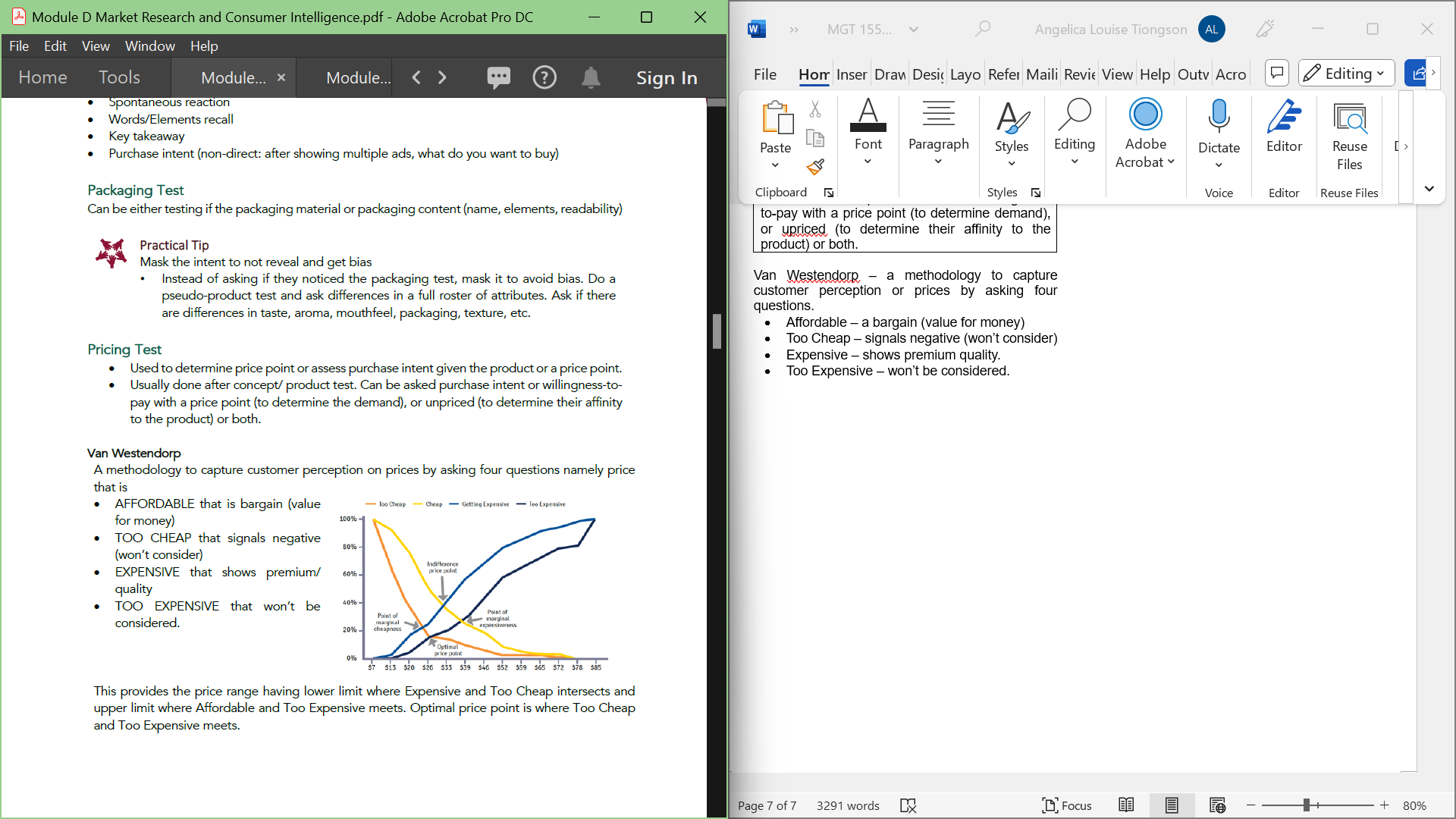
NOTE |
|---|
This provides the price range having lower limit where expensive and too cheap intersects and upper limit where affordable and too expensive meets. Optimal price point is where too cheap and too expensive meets. |
- Consumer Behavior – determining patterns in consumption and purchase which can be done through interviews or observations.
- Use of ethnography (observation) in determining shopping behavior in grocery
- Questions asked:
- Who buys
- What they buy and what they consider in buying
- Why they buy
- How much they are willing to pay
- How many do they buy
- How often do they buy
- Where do they buy
NOTES |
|---|
Observations are powerful. |
Research need not be always about asking questions. One can unearth patterns of how people behave by merely making observations. They are often as or even more powerful as the traditional question-answer types of research as ethnographies are observing behavior over response. |
- Concept-Product Test: one of the most common types of market research where a product or service is being subjected to an evaluation by its target customers.
- Concept Test: services, experiences, ideas, destinations, etc.
- Product Test: products, food, personal care, home care, etc.
Common Questions
Preliminary: Customer Behavior
- Attributes
- 5W’s, 1H
Concept Test
- Spontaneous reaction
- Liking
- Understandability
- Excitement
- Relevance
- Believability
- Purchase
Product Test
- Spontaneous Reaction
- Overall Liking
- Likes & dislikes.
- Attribute evaluation (JAR scales)
- Improvement suggestions
- Purchase intent
Product Test Types
- Face-to-face
- Usually done simultaneously with a researcher and respondents
- Packaged goods, perfumes, makeup.
- Home-Use-Test
- If a product needs to be prepared or needs to be evaluated on a particular use.
- Food that needs cooking
- Shampoo, cleaning agent, soap.
- Central Location Test (CLT)
- When a product is sensitive needs to have a particular means of preparation to be controlled by a company.
- Fast food needs to be served hot or crispy.
- When pressed for time, CLT can accommodate many respondents simultaneously.
- When a product is sensitive needs to have a particular means of preparation to be controlled by a company.
Data Processing
Test: Penalty Analysis & Jar Scales
Questions Asked
- Overall liking of the product
- Likert Scale of 1-9; 1-lowest, 9-highest
- Just About Right Scale with the following scale per attribute.
- 3 – just about right; the preferred state
- 5 – too much
- 4 – slight
- 2 – slightly not
- 1 – not
Measuring the cluster distribution
- Per attribute, identify the % of population who mentioned:
- % of too high
- % of JAR
- % of too low
Identifying the means of overall liking of those clusters
- Calculate the overall liking for each group per attribute.
- Mean of too high
- Mean of JAR
- Mean of too low
Compute for the penalty
- Per attribute, subtract the mean of too low from the JAR means to get the penalty too low as well as get the penalty of too high by subtracting too high mean from JAR mean.
Plot the penalty scores as well as the % of the population.
- This will yield a quadrant where critical corner is shown.
- The more widespread (% consumers) attributes which either too strong or too low with high (more than 1) penalty.
Research Design
- Type of Research
- Research method: Qualitative/Quantitative
- Respondents
- Sample Size
- Sampling
Research Methodology
Qualitative | Quantitative | |
|---|---|---|
Focus | Obtaining information on meanings, opinions, feelings, and motivations of consumer responses. | Measurement of the magnitude, incidence, volume for generalization of an information. |
Example | What are their thoughts on this product. What are their suggestions for improvement. | Do they generally like it? How many? What % is likely to buy it? |
Analysis | Non-statistical, content | Statistical |
Sample | Usually few | Usually large |
Sampling | Purposive | Random/Systematic |
Methods | FGDs, in-depth interviews | Surveys |
Questions | Majority is open-ended | Majority is closed-ended |
Focus | How, Why, What matters | Who, What, When, Where, How, How much, how often, What matters. |
Sample Size: the number of respondents to be involved. Can be computed based on Slovin’s Equation, margin of error or just target number. Best if distinct regions are represented.
Qualitative | Quantitative |
|---|---|
Usually 3-6 FGD groups with 6-7 persons per FGD. | Usually minimum of n=100 representative per target area for consumer groups (or n=300 per country), or n=30 for hard-to-find respondents. |
Respondents: always align with target market in terms of age, economic class, usage, etc.
Sampling Methodology
Type | Explanation |
|---|---|
Probability Sampling | Randomly selects, no bias selection. |
Systematic | Usually from a list, selects respondents by number of interval/skipping |
Stratified Random | Groups the population according to strata and picks a specific sample from each strata. Still random but ensures representation (proportionate) from a specific group. |
Cluster | Groups the entire population in different groups but instead of selecting a representation from each strata, you randomly select an entire group. |
Non-Probability | |
Convenience | Selects those who are convenient to the researcher. |
Purposive | Direct selection of those intended groups. |
Snowball | Selection based on the referral of other respondents. |
Voluntary | Selection based on who intends to answer. |
Research Process and Preparations
Questionnaires – are important as they determine which information is to be collected.
Factors to Consider
- Type of question
- Closed ended – usually for quantitative, having questions answerable by Y/N or coded list.
- Open ended – usually for stories, thoughts, and opinions.
- Neutrality
- Likert Scale
- Even numbers – preference without neutrality.
- Odd numbers – neutrality.
- Bias
- Rotate showcards.
- Rotate products being tested.
Data Analytics
- Always get insights.
- Check for patterns and commonality.
- Always answer your objective
- Do they like the product? Why or Why not?
- Are the product attributes already enough/right using JAR scales? Are there any modifications needed?
- At what price do we set?
TIP |
|---|
Have two columns: one what is the result, and two is the interpretation. |
Other Sources of Information
- Observe behavior through FGDs.
- Just quantify and analyze comments from a post.
- Learn from ratings and comments on online shops.
- Observe a gondola in supermarkets.
- Analyze tweets from a hashtag.
- Check sentiments by looking on the emojis they use.
- Facial reactions
NOTES |
|---|
The key is to be creative in listening among the sentiments of your market. |
Numbers do speak. Words do count. |
Market Entry Strategies
Modes of Entry (Hollensen, 2009)
Cluster | General Means | Mode |
|---|---|---|
Export | Products manufactured in domestic, and then transferred directly or indirectly to a host market. | Direct & indirect export. |
Intermediate | Involvement of variety of agreements to exploit various advantages and still facilitate trade. | Licensing, Financing, Contract Manufacturing |
Hierarchical | Firm owns and controls the foreign entry mode. | Joint venture Greenfield |
Export: manufacturing domestically and transferring directly or indirectly to the home markets.
- Direct Export: producers takes care of export activities (documentation, delivery, pricing) and connect to the touchpoints (resellers, wholesalers) of consumers in the foreign market.
- Indirect Export: similar to direct export but an intermediary (export house, trading company) helps and assists with the administrative export matters.
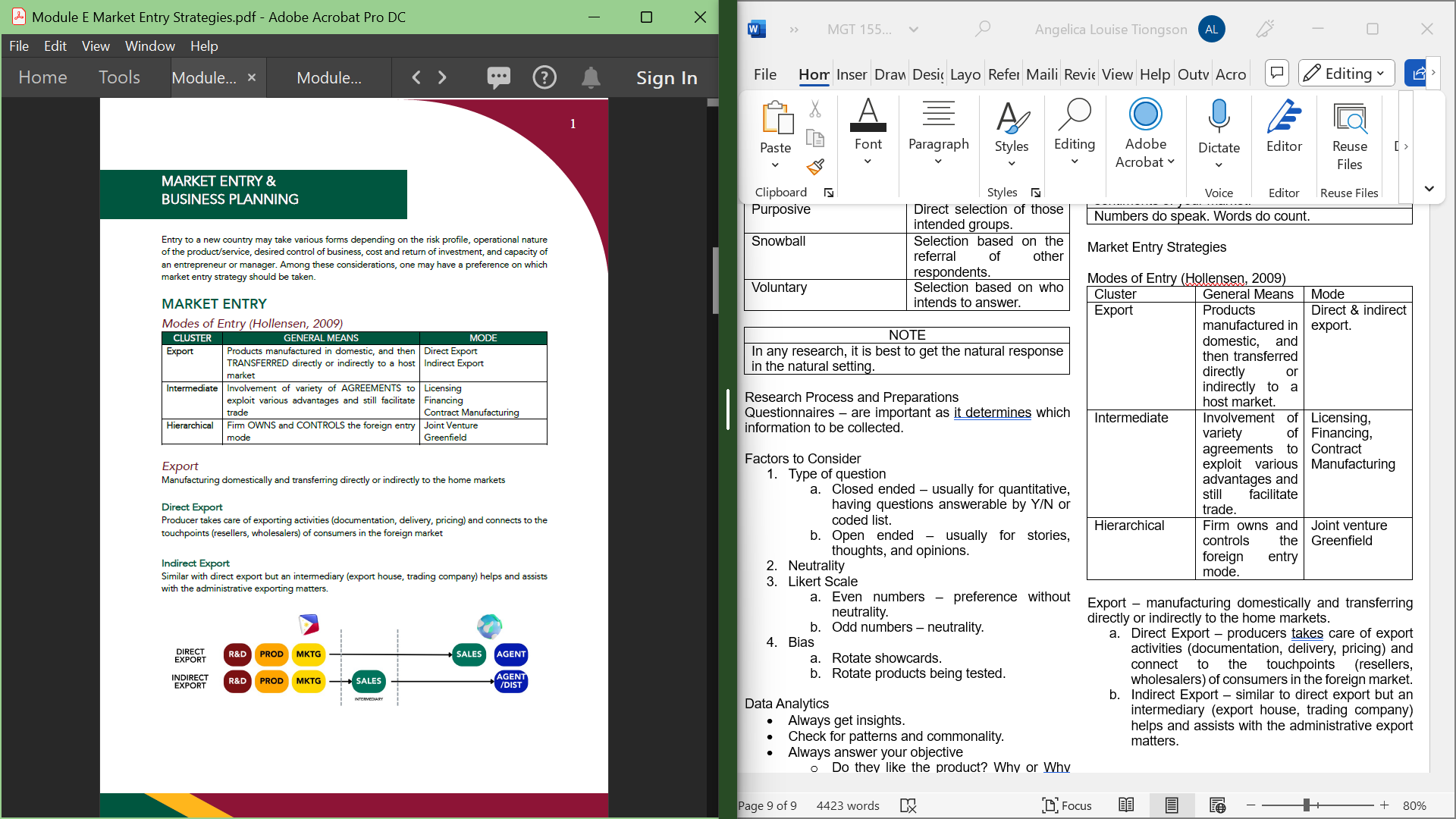
Intermediate
- Licensing: domestic gives rights (Patent, Trademark, Brand name) to a foreign market in exchange for royalties. Usually taken by a well-established business counterpart who knows how to produce and market the products in the home market.
- Franchising: similar to licensing but on a wider scope of the working package or business format. Domestic gives rights to a foreign market in exchange for management fees. Usually taken by a start-up counterpart as this is already well-packaged and the business model is tested.
- Contract Manufacturing: manufacturing is done in the foreign country but the marketing decisions and product decisions by domestic country. Still the control for the brand itself is within the reach of the domestic country.
- Joint Venture: happens when two parent “businesses” creating the child “joint venture” business. It is an equity partnership which means both parties have ownership of the new business created. Usually done to take advantage of each of the strengths of the parent business. Partners in the foreign country usually speed up diffusion of the domestic product given their experience.
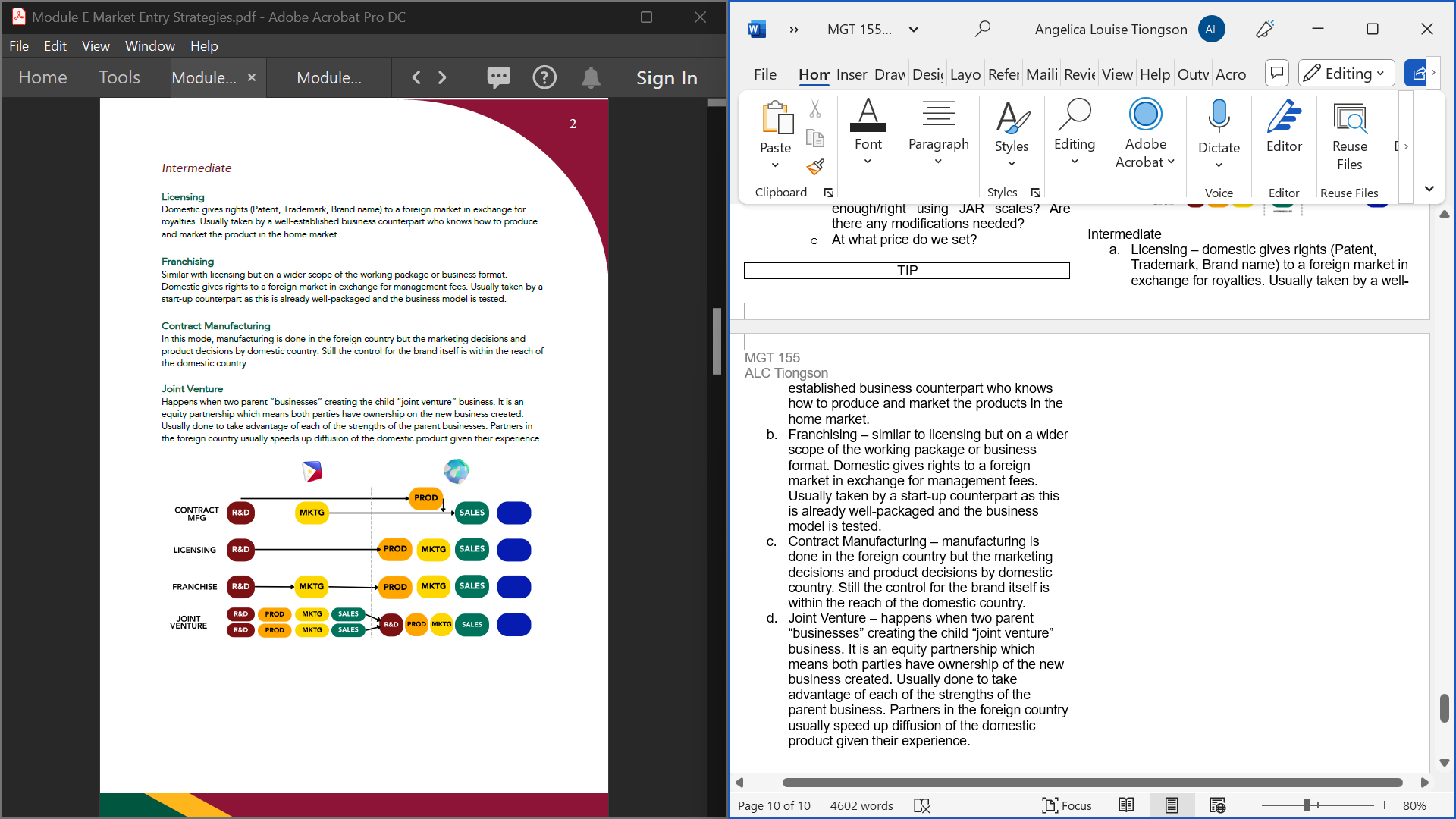
Hierarchical
- Acquisition: acquiring a company for quick access to distribution, existing customer base, brand name, and reputation, etc.
- Greenfield: generally building or establishing a new business or establishing new operations in the foreign country.
- Domestic Sales Representative: having a representative who will offer the product in the foreign market but still the representative is based in the domestic market. The difference with an exporter is that these representatives are direct to consumers instead of an agent/retailer/wholesaler who has control over the decisions.
- Resident Sales Representative: having an actual representative who will offer the product, assigned to a foreign country.
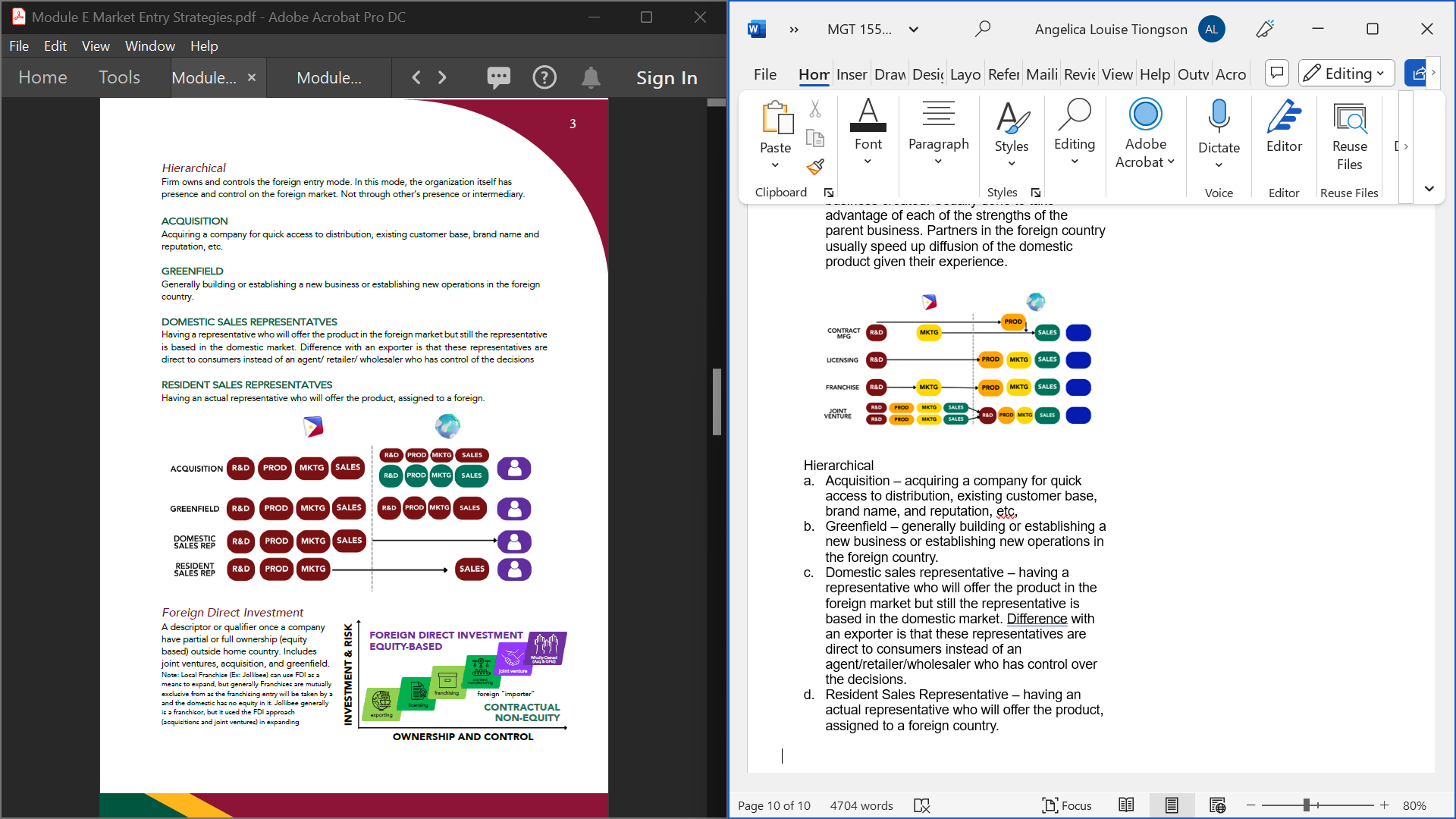
Foreign Direct Investment: a descriptor or qualifier once a company has partial or full ownership (equity based) outside home country. Includes joint ventures, acquisition, and greenfield.
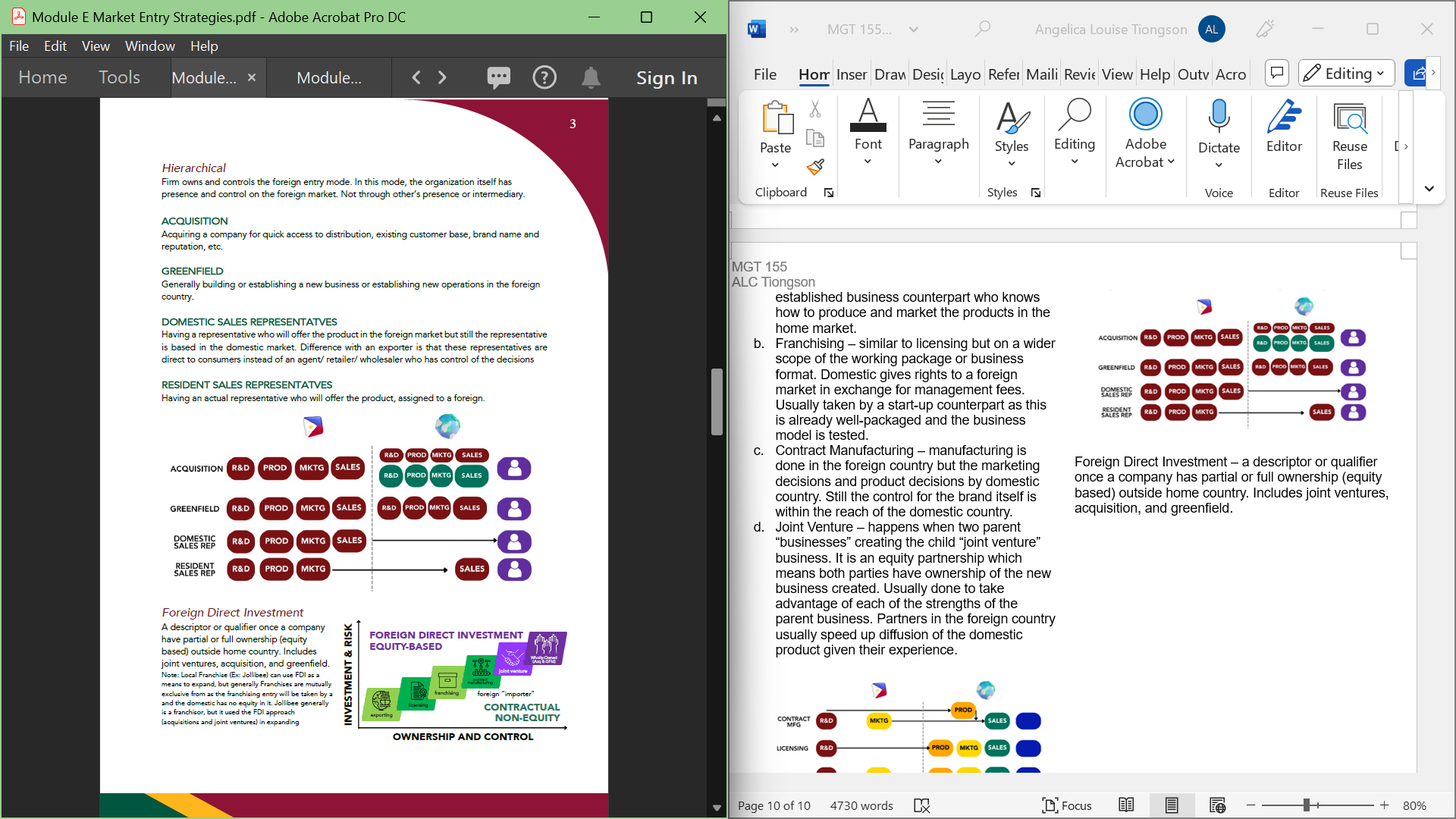
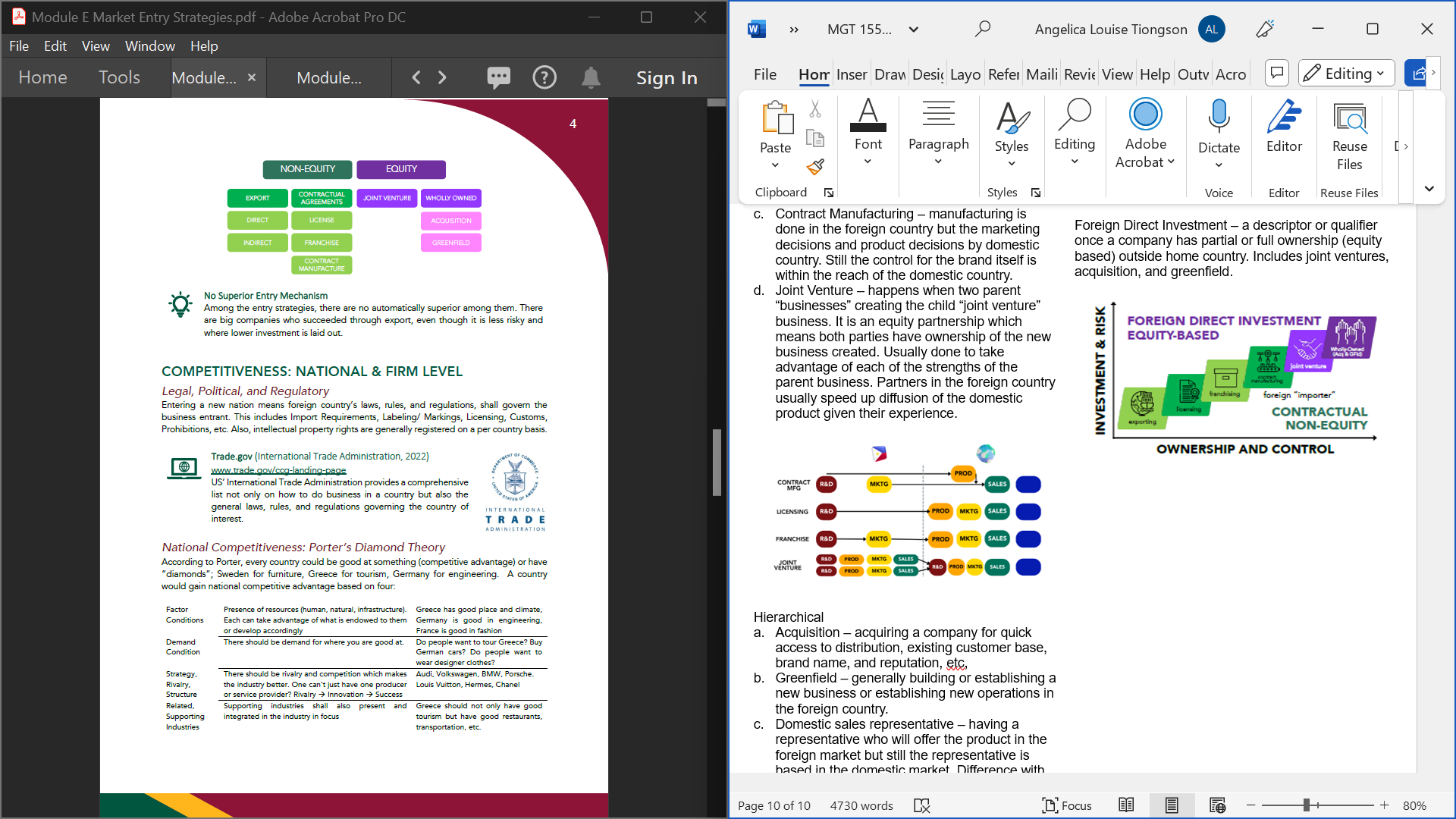
Among the entry strategies, there are not automatically superior among them. There are big companies who succeeded through export, even though it is less risky where lower investment is laid out.
Competitiveness: National & Firm Level
Legal, Political, and Regulatory: entering a new nation means foreign country’s laws, rules, and regulations, shall govern the business entrant. This includes import requirements, labelling/markings, licensing, customs, prohibitions, etc. Also, intellectual property rights are generally registered on a per country basis.
National Competitiveness: Porter’s Diamond Theory
Factor Conditions | Presence of resources. Each can take advantage of what is endowed to them or develop accordingly. |
|---|---|
Demand Condition | There should be demand for where you are good at. |
Strategy, Rivalry, Structure | There should be rivalry and competition which makes the industry better. One can’t just have one producer or service provider. Rivalry 🡪 Innovation 🡪 Success |
Related Supporting Industries | Supporting industries shall also present and integrate in the industry in focus. |
NOTES |
|---|
The most enduring competitive advantage for nations is created for those that have the least degree of mobility. |
Climate is hard to replicate, hence, those endowed with a climate suitable for a product or service would tend to have a competitive advantage on that. |
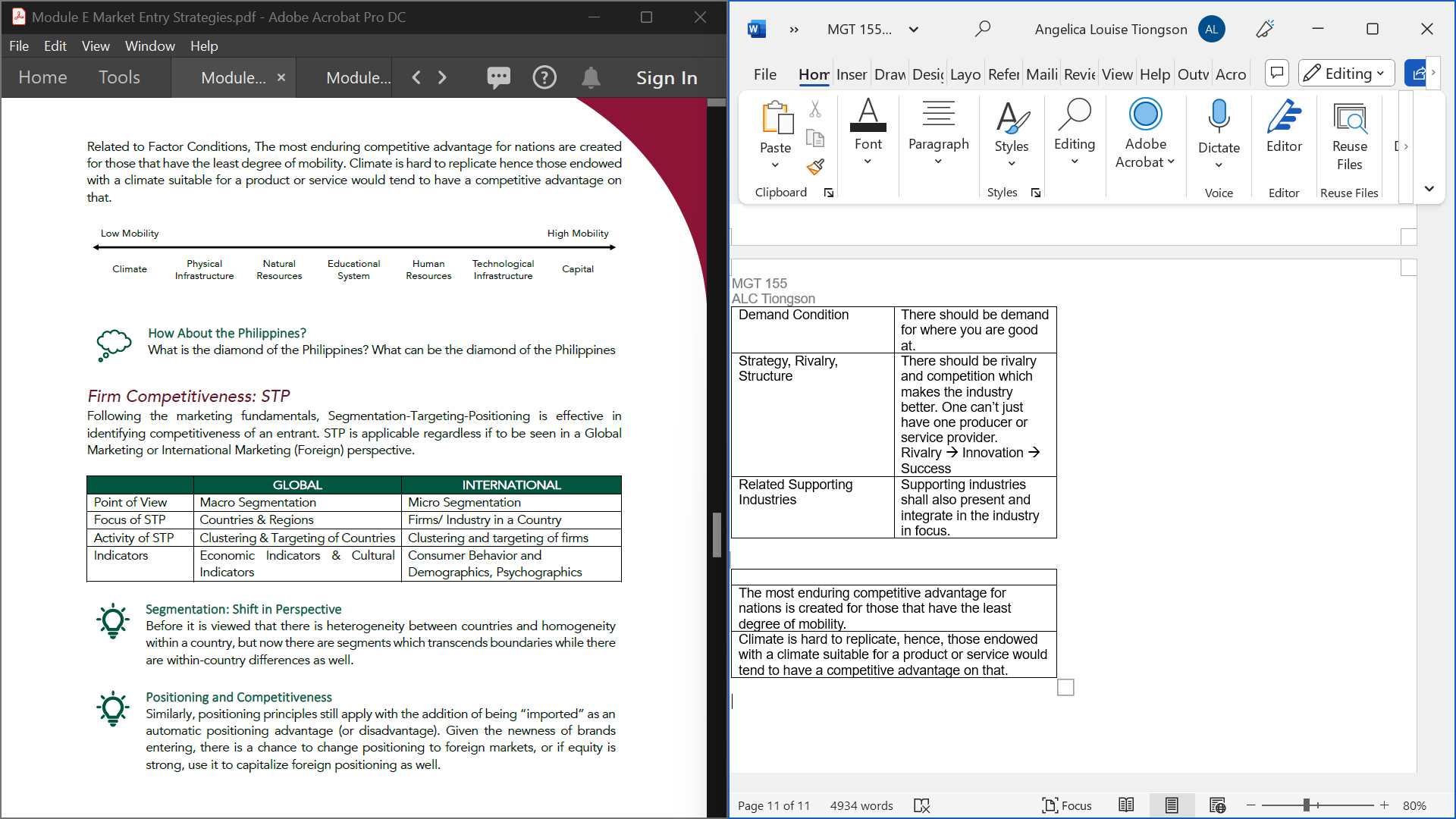
Firm Competitiveness: STP
Segmentation-Targeting-Positioning: effective in identifying the competitiveness of an entrant. It is applicable regardless of whether the perspective is global or international.
Global | International | |
|---|---|---|
POV | Macro segmentation | Micro segmentation |
Focus of STP | Countries & Regions | Firms/industry in a country |
Activity of STP | Clustering & targeting of countries | Clustering and targeting of firms |
Indicators | Economic indicators and cultural indicators | Consumer behavior and demographics, psychographics |
- Before it is viewed that there is heterogeneity between countries and homogeneity within a country, but now there are segments which transcends boundaries while there are within-country differences as well.
- Similarly, positioning principles still apply with the addition of being “imported” as an automatic positioning advantage (or disadvantage). Given the newness of brands entering, there is a chance to change positioning to foreign markets, or if equity is strong, use it to capitalize foreign positioning as well.
Business Model Canvas: a simple tool which helps marketers plan businesses more effectively and more efficiently. The simplicity of BMC being able to plan and encapsulate the essentials of the enterprise using a bond paper and nine building blocks, allows marketers not to be overwhelmed about creating a business plan.
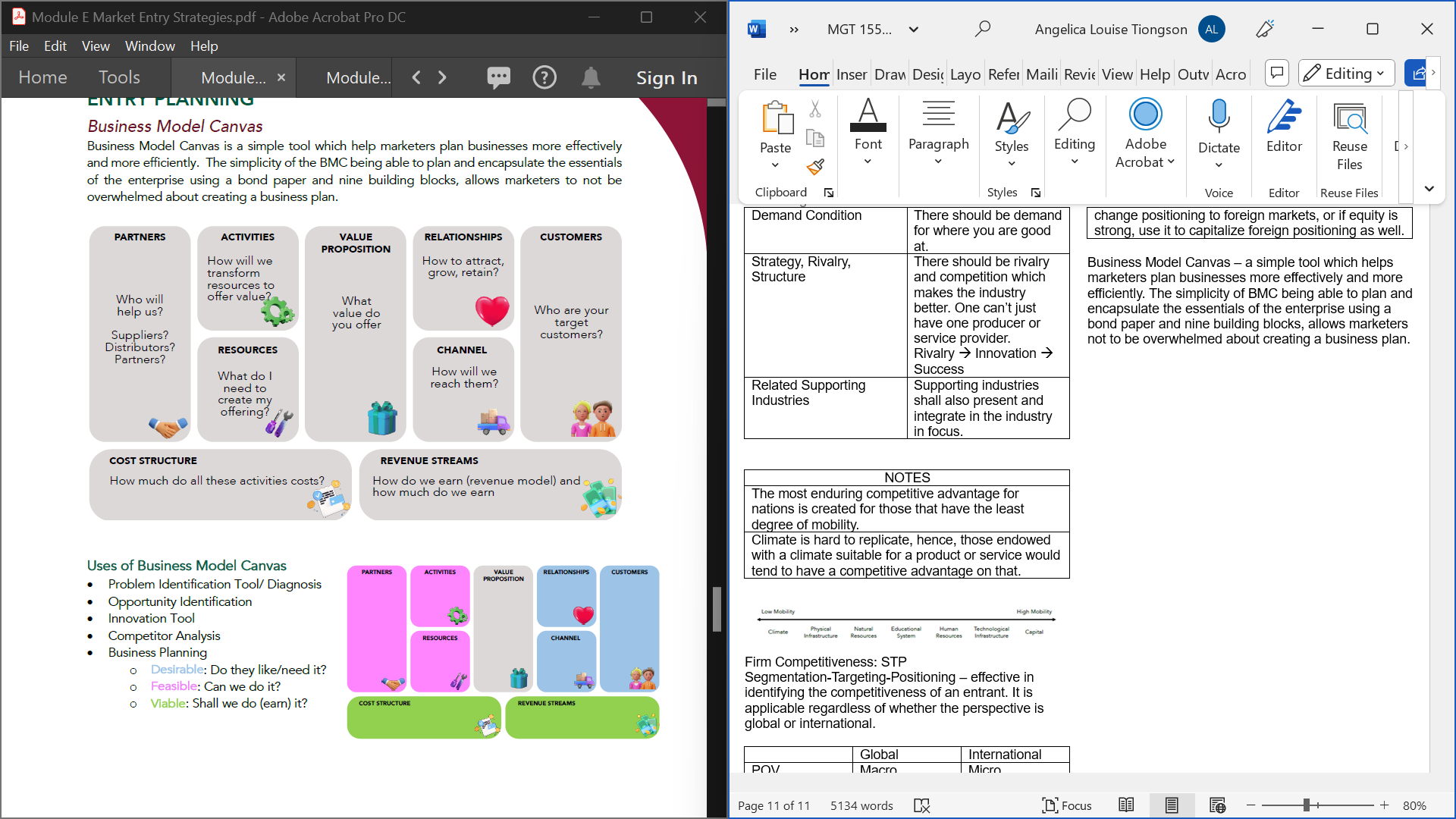
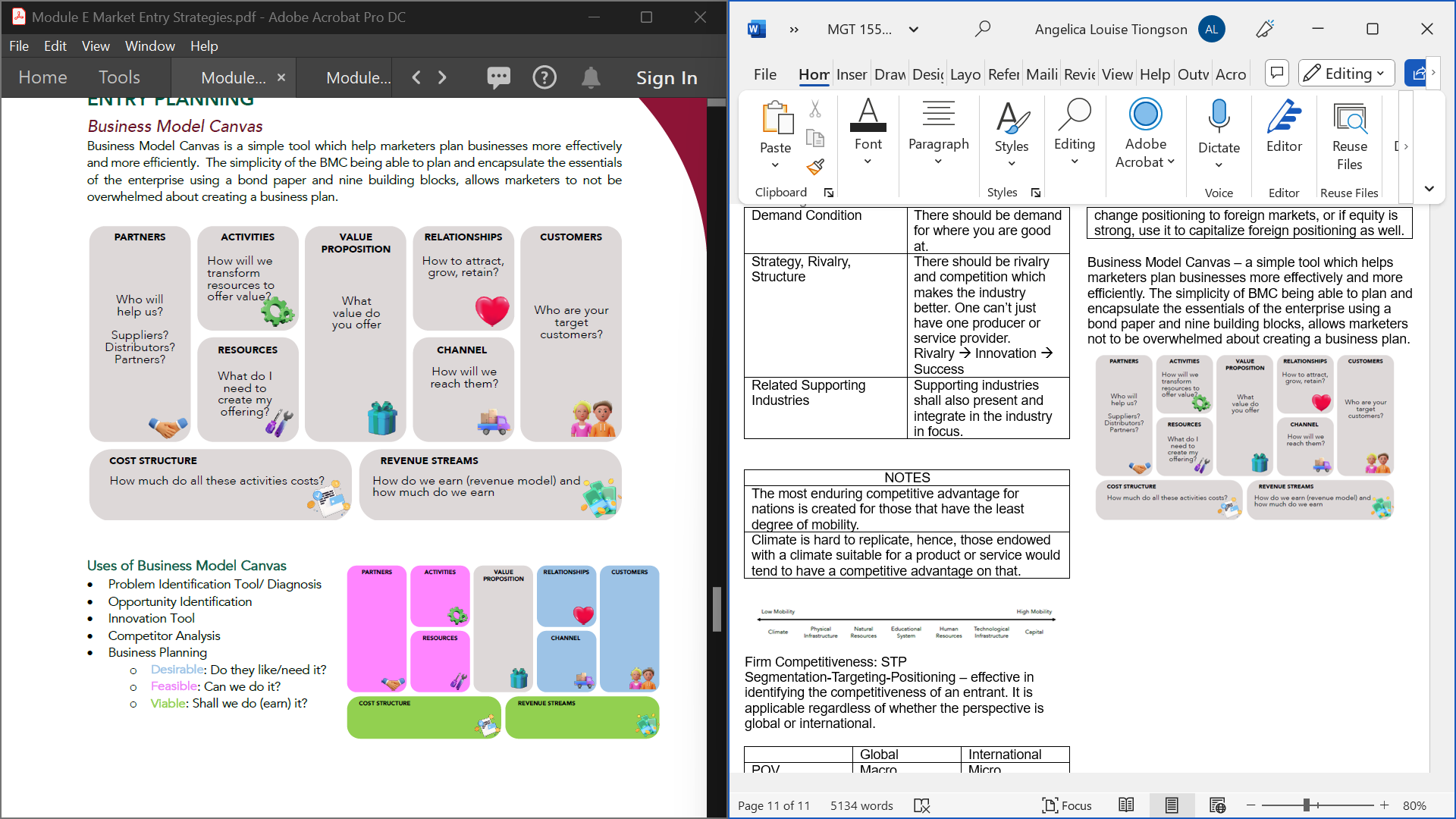
![]()
![]()
![]()
Uses of Business Model Canvas
- Problem Identification Tool/Diagnosis
- Opportunity Identification
- Innovation Tool
- Competitor Analysis
- Business Planning
- Desirable: Do they like/need it?
- Feasible: Can we do it?
- Viable: Shall we do (earn) it?
Product, Service, & Branding Strategies
Product Decisions
Standardize vs. Adapt (Onsikit & Snow, 2004)
Standardize | Adapt | |
|---|---|---|
Strategy | Selling a product similar to the local market (source country). May have differences in packaging, label, and translation. | A product which considers cultural and consumer variations. |
Supporting Arguments | Economies of Scale | Satisfies the consumers in a more aligned manner |
Lesser Costs (same production, communications) | Strategic towards competitors | |
Simpler | May convey consumer-centeredness | |
Some products need to be mandatorily adjusted regardless | ||
Profitable in the long-term | ||
Counter Arguments | Not all cost reductions lead to profit improvements | Converging of needs of consumers |
More costly | ||
Loss of identity of imported product | ||
Rationale | When a consistent company or product image is needed | When the cultural factors are strong and significant |
Factors Affecting Standardization & Adaptation Decision
Market Characteristics | Product Characteristics | Company Considerations |
|---|---|---|
Regulatory | Attributes | Profitability |
Consumer Behavior, Preferences, Economic Class | Packaging | Market Opportunity |
Culture | Functions & Form | Cost of Adapting |
Economic Stage | Durability & Quality | Company Image |
Competitors | Country of Origin | |
Climate |
NOTE |
|---|
The choice of standardization or adaptation is not an all-or nothing proposition but to which degree you standardize or adapt. |
Local, Global, Glocal
Globalization: comprises of a global strategy for where products or services suit worldwide customers’ needs regardless of their local cultures and traditions. A global and undifferentiated product due to convergence in customer preferences or mass demand.
- Aligned with global marketing, having the image of being a global product, brands may use it as a leverage towards brand equity in entry.
Localization: a strategy where a company embraces and mimics local strategies appealing as a local product. Addressing the cultural and linguistic barrier to appeal to the local user and circumstances. Tailored to conform with local customs, cultures, and consumers.
Glocalization: is a strategy, mindset, and method where products and services are produced at the lobal level but are adapted to meet local market’s requirements and is tailored to conform with local customs, laws, culture, and consumers.
Determinants of Decisions
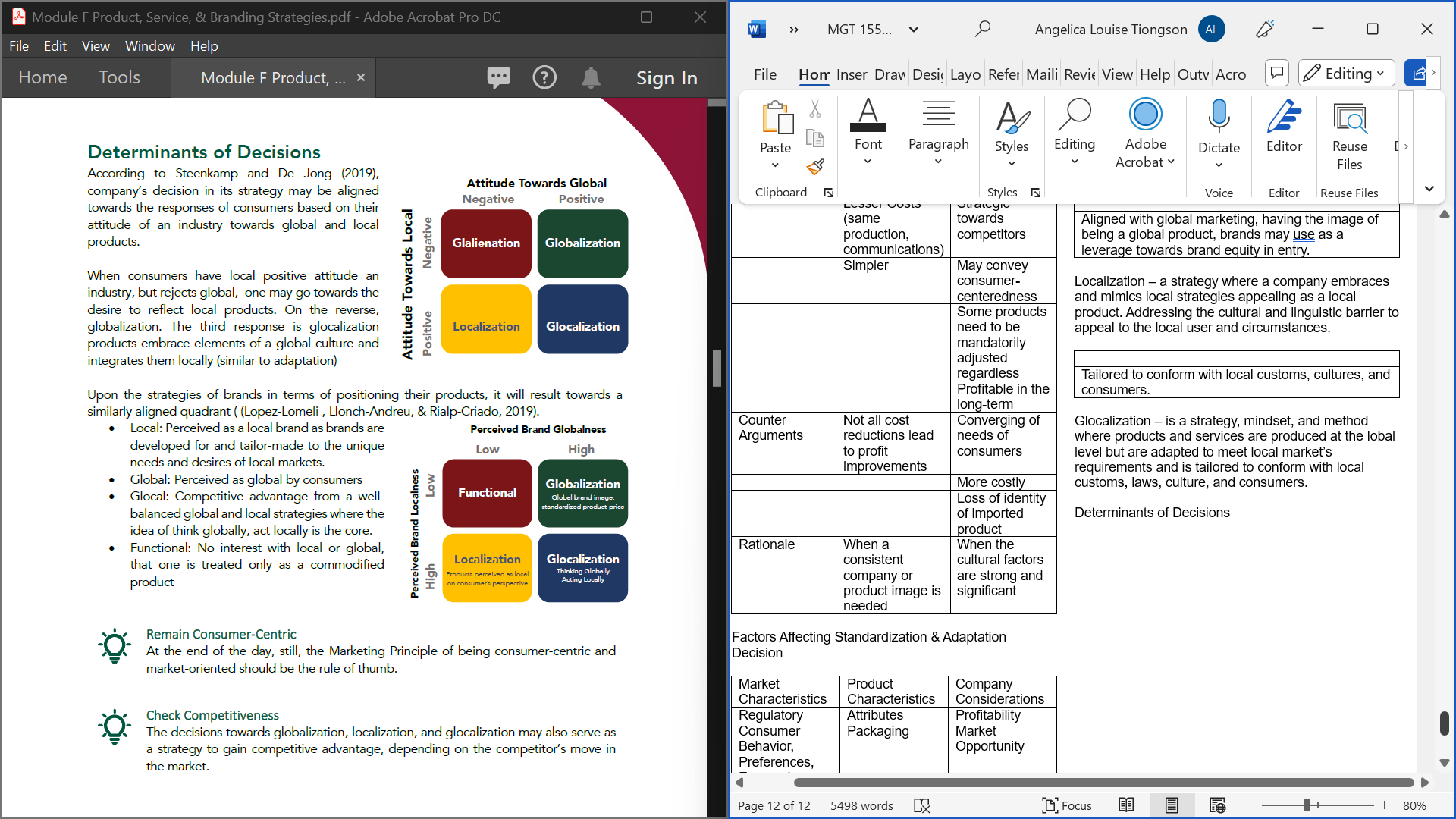
Steenkamp & De Jong (2019)
- A company’s decision in its strategy may be aligned towards the responses of consumers based on their attitude of an industry towards global and local products.
- Localization: Positive on industry, negative on global.
- Globalization: Negative on local, positive on local.
- Glocalization: Embraces elements of global culture and integrates them locally.
Perceptions
- Local – perceived as a local brand as brands are developed for and tailor-made to the unique needs and desire of local markets.
- Global – perceived as global by consumers.
- Glocal – competitive advantage from a well-balanced global and local strategies where the idea of think globally, act locally is the core.
- Functional – no interest with local or global, that one is treated only as a commodified product.
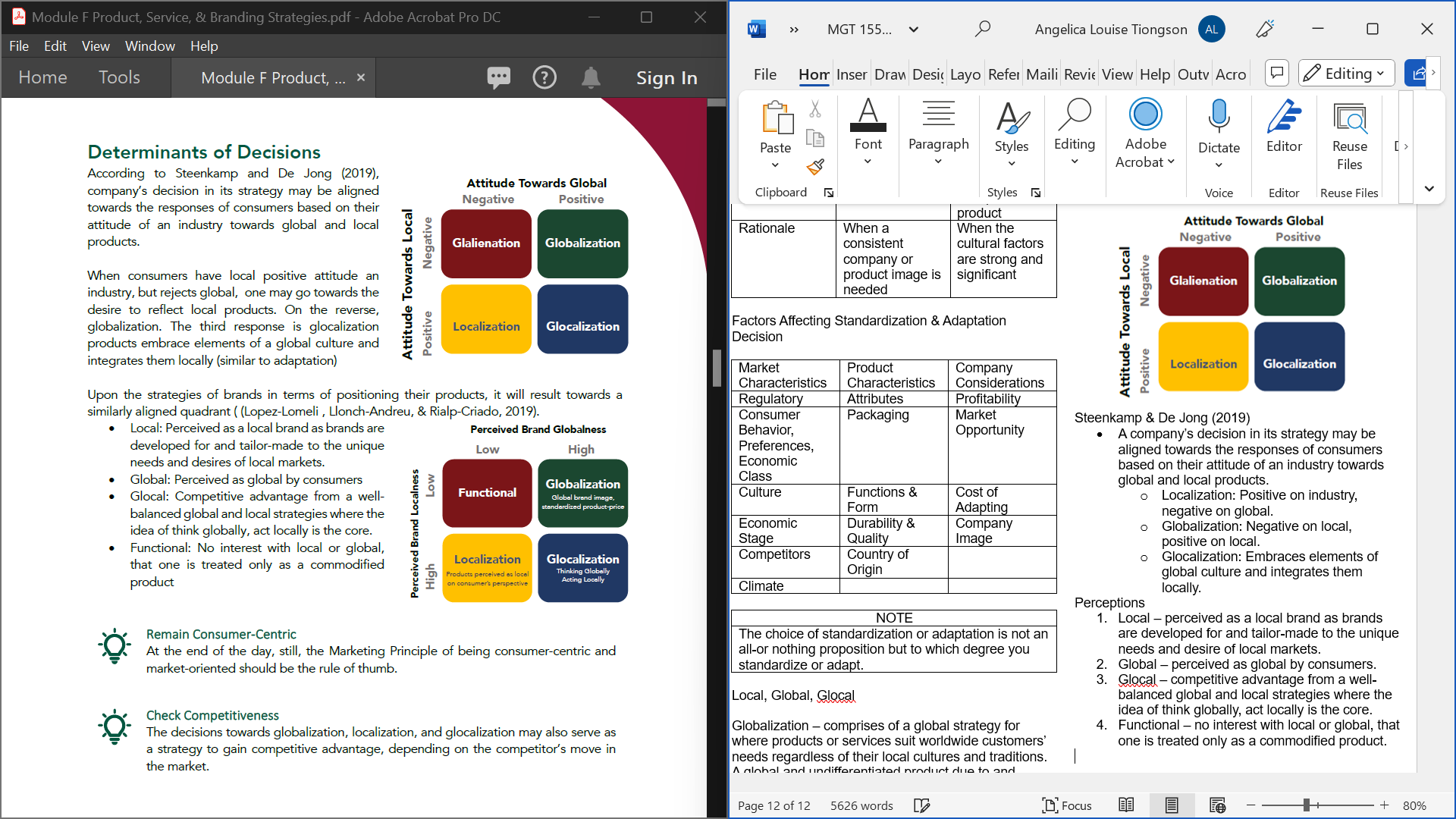
Things to Remember
- Remain consumer-centric and market-oriented.
- Check competitiveness.
Innovation & the International Market
S | Substitute | Replacing something that already exists |
|---|---|---|
C | Combine | Create something unique from put together two unique items |
A | Adapt | Adapt for a specific audience. Adapt for an industry |
M | Modify, magnify, minimize | Making noticeable modifications among competitors’ product |
P | Put to other use | Use of product or byproduct somewhere else |
E | Eliminate | Remove something to streamline. Remove features to be different. Remove product pain points |
R | Reverse, rearrange | Reorder to make your product look or feel different. |
Branding in the Global Market
Branding: developing a compelling, positive, and lasting image of your business that creates an emotional connection with your customers. It is who you are, and how your target market sees you.
Branding Globally/Internationally
- Provides automatic quality certification.
- Global brands seem to have better and higher equity.
- How they perceive you and its effect on purchase
- How to brand if you are new in the nation
- How to align brands among various nations
Brand Adjustments
- Translation
- Transliteration
- Check for connotative meaning.
- Meaningless brand
- Transcultural
- Vodka 🡪 Russian sounding names
- Perfume 🡪 French sounding names
Country of Origin Effect (COO): activation of association (+/-) in consumer minds which affects propensity to buy. A heuristic where people assess a product based on where it comes from.
Three Components of COO and Consumer Behavior
- Cognitive
- People generally lack detailed info about a brand/product and use COO to evaluate quality level.
- Turns out to be a heuristic that can help consumers refer to quality and influences beliefs about products.
- Affective
- COO can evoke affective and symbolic value.
- Normative
- Purchase driven by desire to support the economy of a given country (COO)
Dimensions to Understand COO Effect
- Country Image: general perceptions based on a country level of economic, political, and cultural. Total of all the descriptive, inferential, and informational beliefs one has about a country.
- Country Product Image: based on innovation, quality, and prestige of a country’s manufacturing.
- Country Related Product Image: based on a reputation of a specific product product/brand from a country that reflects technical characteristics, reliability, and status.
The overall CI indirectly influences consumer purchase intent due to two mediating variables: 1) linked towards a country’s manufacturing (CPI) and the other to the image of a specific product from that country (CRPI).
Country Equity: portion of consumer affect towards a brand or product that is derived purely from the product’s associations with a particular country.
Brand Origin Culture (COBO): looks at the cultural characteristics appended to a brand which is based on the linguistic and cultural aspect of the brand name.
Brand Origin Culture
Based on COO and influence on Brand Product-Brand Matrix
Consumers associate the image of a country not only with the capabilities of a specific sector or product category but also with the ability to produce good brands.
Product Centric | Brand Centric | Example |
|---|---|---|
Strong | Strong | BMW is a known brand from Germany which is known for manufacturing cars. |
Strong | Weak | Turkey is known from making carpets but no brand is widely known from it. |
Weak | Strong | Swarovski us a known brand but Austria is not known for it. |
Geographic Indicator
- Product origins which are backed-up by Intellectual Property Rights
- Generally, to attribute its quality, reputation, and characteristics to a locality
- Protection towards product origin or a traditional know-how of its manufacturer to preserve the quality, identity, and tradition.
- There is an IP protection that other manufacturers or offerors of service cannot brand or use these indicators if not from that specific geography.
- Geography may have various influence on the brand itself, hence, it should be determined if marketer would capitalize in it and make brand elements such as packaging, promotions, have prominent elements of it.
Three Levels of Protection by the Intellectual Property Rights
IP Rights | Protected Designation of Origin (PDO) | Protected Geographic Indication (PGI) | Traditional Specialty Guaranteed (TSG) |
|---|---|---|---|
Condition | Every part must take in a specific region. | At least one stage of production, processing, or preparation takes place in the region. | Having specific character, raw materials, production methods and processing must be traditional. |
Nation Branding: How a country positions and promotes itself as a place for people to visit, invest in, and build a good reputation for their quality of goods and services as well as talent.
- Investing in Nation Branding, though in the realms of Tourism, may have a ripple effect towards brands.
Place and Price Strategies
International Place & Distribution Strategy: satisfaction is anchored less on how the product or service satisfies, but more in consideration of the entire customer experience.
- Place strategies play a crucial role in bridging the gap among borders and making products and services available to the international market. Selecting the appropriate distribution strategies also entails costs which affects pricing and revenues.
Place Objectives: aims to ensure that products and services are available and accessible to its target consumers.
Place | Convenient and Coverage |
|---|---|
Time | When Desired/Needed |
Amount | Quantity |
Form | Quality and Condition |
Support | Customer Support |
Distribution Mix
Mix | Description |
|---|---|
Coverage | Where will you be available geographically and digitally. |
Placement/Outlet | Being carried in a store/channel it wants. |
Volume | Right inventory at the stores. |
Display | In-store shelf placement. |
Product State | Condition of goods upon purchase. |
Resale Price | How much customers will be able to pay? |
Good Will | Value chain relationships among foreign partners. |
Distribution Chain/Process: the chain emulates the domestic distribution chain, with the addition and consideration of intercountry/cross-border exchange and transportation mode which involves port activities.

Transportation Mode
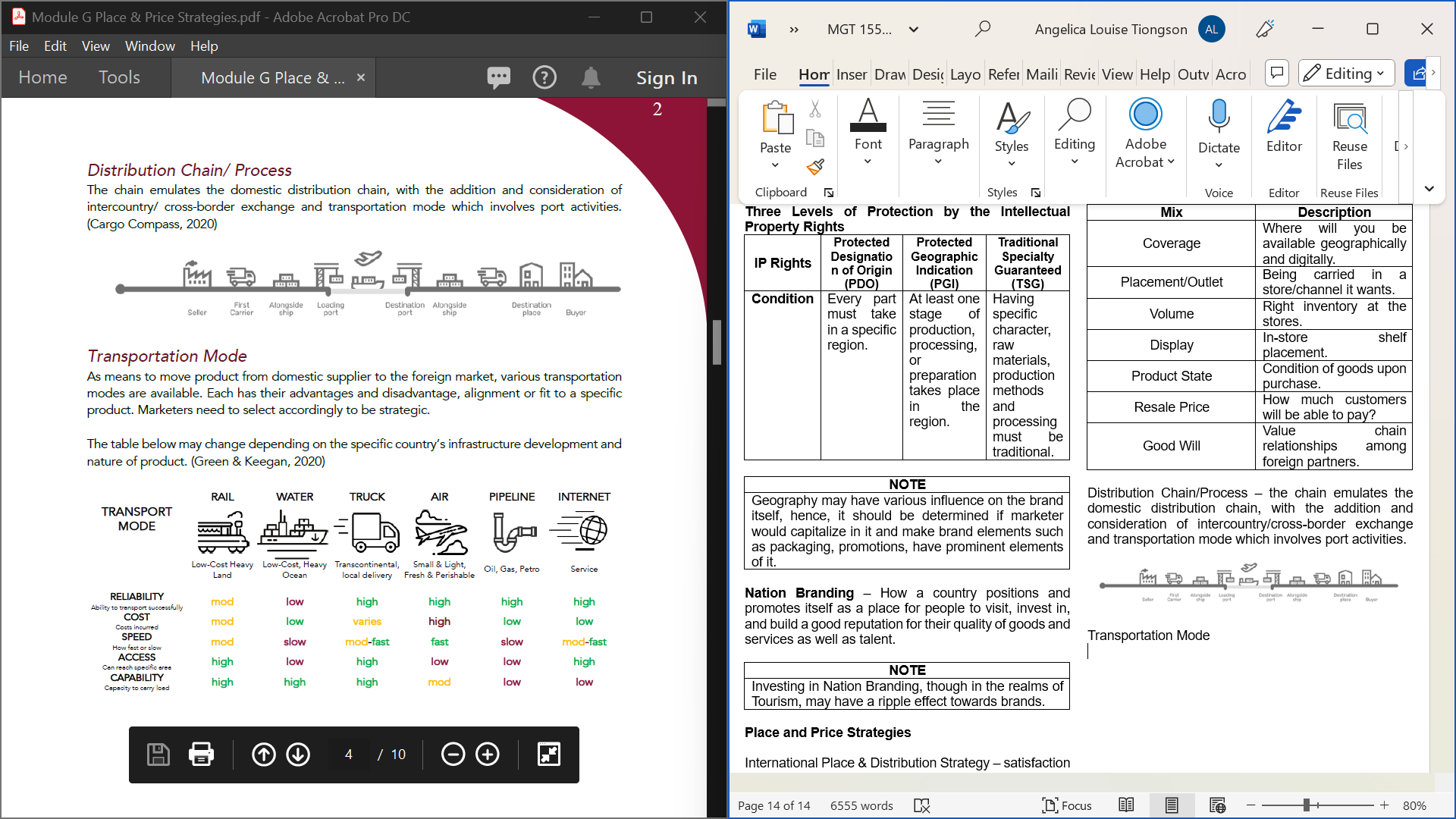
Channels/Customer Touchpoints
- In the foreign market, it is important to consider which touchpoints are aligned with products and the consumer behavior.
Channel | Description |
|---|---|
Specialty Store | Carries narrow/limited and focused product line. |
Department Store | Carries several diverse products. Personal to household. |
Superstores | Very large catering total needs. |
Supermarket | Semi-large, near residential, for FMCG & convenience products. |
Convenience Store | Semi-small store, long hours, FMCG at higher prices. |
Grocery | Small version of supermarket, closer to neighborhood, pricing along SRP. |
Discount/off-price | Standard merchandise at lower price. |
Bazaar/Kiosks/Pop-up | Usually, a specialty which is not permanent. |
Expos and Trade Fairs | Used to showcase a specific industry, country, etc. |
Online Platforms | Facilitates trade, exchange of goods, having integrated payment and delivery, taking in charge of administrative matters. |
Terms of Deliver: Based on Incoterms (International Commercial Terms), a code/nomenclature is established by ICC (International Chamber of Commerce) to unify terms among trading countries. (ICC, 2020). Depending on the agreement of the buyers (foreign) and sellers (domestic), the following term of delivery shares the obligations of each and where the transfer of risk happens.

Considerations in Distribution
Buying Behavior | Buyers of motorcycle in Asia typically are for family use, wherein for America for bachelors mainly. Americans are used to bulk buying (hence proliferation of Walmart), while Asians consume in sachets. |
|---|---|
Product Service Characteristics | Hazardous? Perishable? Fragile? Does it need face-to-face interaction/selling or agents? |
Location & Coverage | Proximity to port and retail channels? Will we be available nationwide or a specific region? What are the popular online platforms? |
Competition | Who are the competitors and what are their strategies? |
Local Business Practices | Is it customary to give tips? Are there any culture influences in treating employees? In Latin America, power and status is important. Importance of bow in Japan. |
Legislation | Are there any laws concerning distribution? Japan has limit in space resulting to limited store size, and how space efficient are their rooms and packaging. |
Customer Support | Do they like text? Instant Message? Telephone? |
Costs | Will costs of delivery, compliance, and adjustment be covered by revenues? |
Weather | How will you adjust your packaging? Display? Etc. |
Carbon Footprint | Growing concern of people towards being socially responsible. |
- It is important to have a mindset that the supply chain players are not just simply distributors or transporters of products but as valuable partner in the business. Not just as temporary mediators, but long-term partners.
- They know the market, the consumers, and how to play the game, hence, control may be reevaluated for more synergistic marketing collaborations.
Customer Journey Mapping & Customer Experience
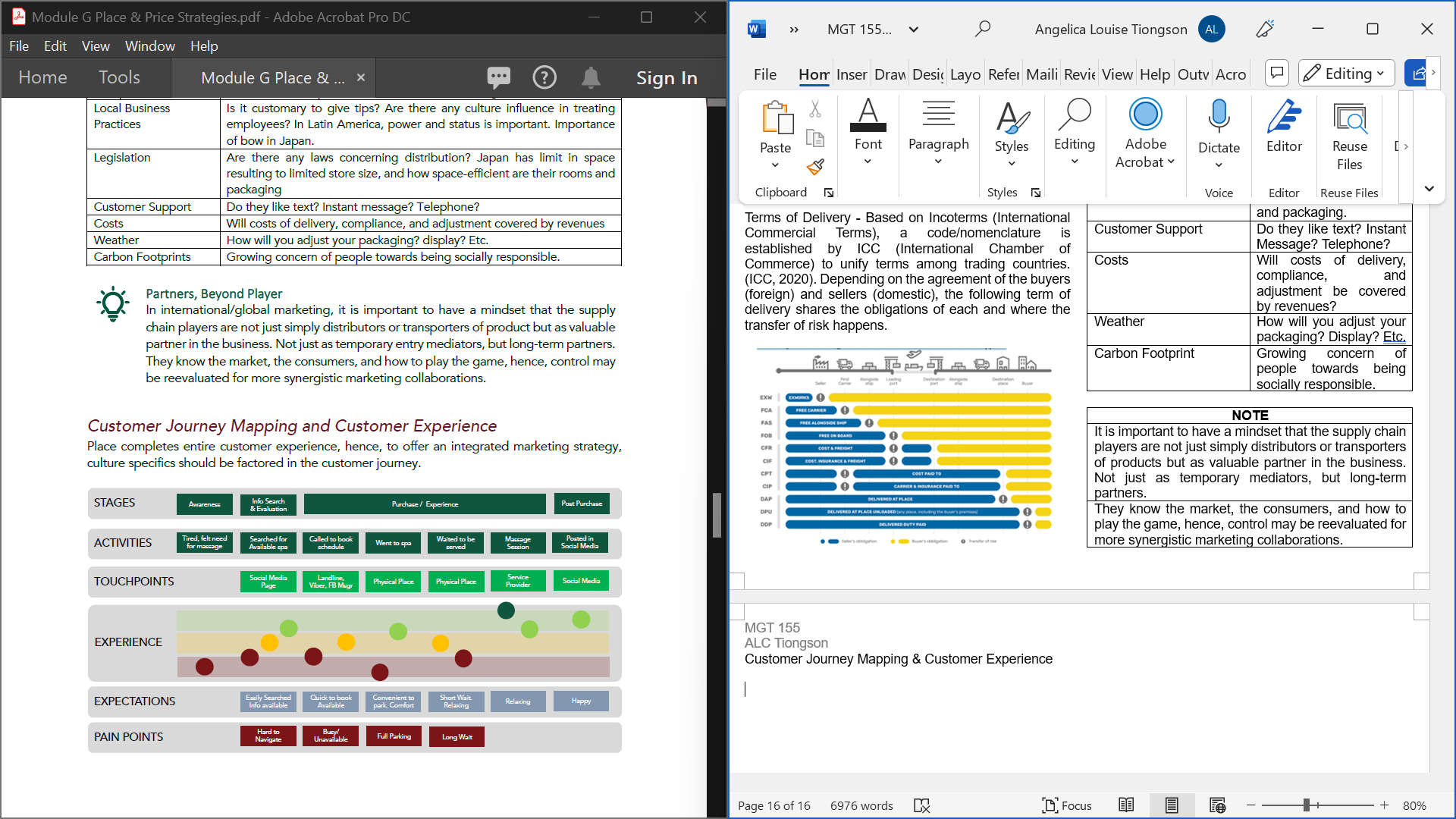
- Place completes entire customer experience, hence, to offer an integrated marketing strategy, culture specifics should be factored in the customer journey.
Eight C’s of Pricing: Factors Affecting International Pricing
Price, first and foremost, is a strategy. Beyond numbers, it conveys and communicates meaning and connects to people, among the sea of competitors, giving them decision whether it is of value to them or not.
Three Main Factors
- Costs – provides the floor price.
- Consumer Demand – sets the ceiling price.
- Competitors – everything between.
- Control of the Government – tariffs, duties, fees, and local taxes.
- Cost of Living – purchasing power and income.
- Currency and exchange rates - exchange rates and its volatility.
- Channel Costs – transportation and distribution fees.
- Cultural Differences – perception from country of origin and branding.
Entry Pricing
Penetration | Skimming | |
|---|---|---|
Price Point Strategy | Low price to attract large number of buyers and market share. | High price to skim max revenues recover costs. |
Best Fit for Products | Mass market/consumer goods. | Innovative products, little or no competition in the market. |
Demand Type | Relatively elastic | Relatively inelastic |
Future Direction | Raise price as firm becomes established | Lower price to extend sales too new segments. |
Cons | Can devalue a product. An increase in price may cause a loss of customers. | Encourage competition. If set at a low price, impact on brand image. |
Pros | Higher demand. | Association with Higher Quality. |
Price Computation: the distribution strategies and regulatory components, as it incurs costs, should be considered computing the price.
CIF | TARIFFS/DUTIES | TAXES | OTHER FEES | LANDED COST |
|---|---|---|---|---|
Cost Insurance Freight | Tariffs are taxes (usually in %) imposed on imports. | Custom fees | Local Delivery | Total Price of a product once it has arrived at the buyer’s doorstep |
Value added taxes | ||||
It is called duties when computed (actual amount) | National & Local | Markups | ||
Sales Taxes |
Tariffs and Duties: are taxes on imported goods set by the destination country. Usually expressed in % of the CIF, it varies per nation. When computed, the actual amount resulting to the tariff is called duties.
- Tariffs/duties differ on various trade membership and bilateral agreements of countries. For specific rates, trade.gov have a database.
Classification of Tariff
- General Rate: rate for non-WTO members which is typically higher.
- Most Favored Nation (MFN): a lower rate given to WTO signatory countries.
- Bilateral Rate: Special rates made from various specific agreements between countries.
Considerations and Strategies in Pricing
- Bottom of the pyramid – not all consumers can afford it.
- How will the consumers who belong to the BOP pay products or avail services if they have unstable and unpredictable income streams?
- Loss leader – pricing few items below cost to drive traffic in and gain interest.
- In the overall, revenues still remain positive given spillovers on other products.
- When done in a foreign market, loss leader is termed dumping. This works as imported products have back-up revenues on other markets outside the region while smaller domestic companies can’t withstand the loss. Oftentimes, this is being regulated for being anti-competitive.
- Predatory Pricing/Dumping Pricing Strategy
- Predation – setting a price at an unrealistic rate to drive out competition while absorbing initial loss.
- Recoupment – going back to normal price levels after gaining enough potential profitable.
- Grey Market – unauthorized selling by other non-official distributors through parallel importing. Due to variations on tariffs, taxes, and transportation, distributors in a country receiving lower total costs have the incentive to illegally distribute it on another country which obtains a higher total price for the product.
Pricing Research & Pricing Tools – use Van Westendorp.